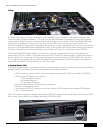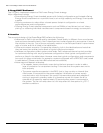
Dell™ PowerEdge™ R610 Technical Guidebook
12
The LCD panel is a graphics display controlled by the BMC/ESM. Both ESM and BIOS can send error
codes and messages to the display.
The system's LCD panel provides system information and status messages to signify when the system is
operating correctly or when the system needs attention.
The LCD backlight lights blue during normal operating conditions and lights amber to indicate an error
condition. When the system is in standby mode, the LCD backlight is o and can be turned on by
pressing the Select button on the LCD panel. The LCD backlight will remain o if the "No Message"
option is selected through the iDRAC6, the LCD panel, or other tools.
BIOS has the ability to enter a “Secure Mode” through Setup, which locks the power and NMI buttons.
When in this mode, pressing either button has no eect but does not mask other sources of NMI and
power control.
K. Security
I. Cover Latch
A tooled entry latch is provided on the top of the unit to secure the top cover to the chassis.
II. Bezel
A metal bezel is mounted to the chassis front to provide the Dell ID. A lock on the bezel is used to
protect un-authorized access to system peripherals and the control panel. System status via the LCD is
viewable even when the bezel is installed.
III. Hard Drive
The optional front bezel of the system contains a lock. A locked bezel secures the system hard drives.
IV. TPM
The TPM is used to generate/store keys, protect/authenticate passwords, and create/store digital
certificates. TPM can also be used to enable the BitLocker™ hard drive encryption feature in Windows
Server
®
2008. TPM is enabled through a BIOS option and uses HMAC-SHA1-160 for binding. There will be
dierent planar PWA part numbers to accommodate the dierent TPM solutions. The “Rest of World”
(ROW) version will have the TPM soldered onto the planar. The other version of the planar (post RTS
and primarily for use by China) will have a connector for a plug-in module.
V. Power O Security
The control panel is designed such that the power switch cannot be accidentally activated. The lock on
the bezel secures the switch behind the bezel. In addition, there is a setting in the CMOS setup that
disables the power button function.
VI. Intrusion Alert
A switch mounted on the left riser board is used to detect chassis intrusion. When the cover is opened,
the switch circuit closes to indicate intrusion to ESM. When enabled, the software can provide
notification to the customer that the cover has been opened.
VII. Secure Mode
BIOS has the ability to enter a secure boot mode via Setup. This mode includes the option to lock out
the power and NMI switches on the Control Panel or set up a system password. See the Whoville BIOS
Specification for details


















